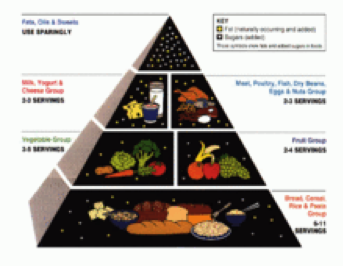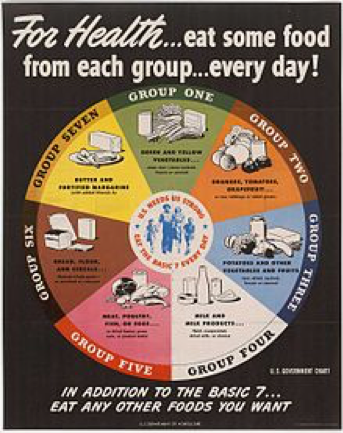|
Most everyone is familiar with the iconic Food Pyramid icon, the nutritional profile of suggested healthy eating produced by the government. With its foundational category of breads, pastas, and whole grain foods, this model was considered by multiple governmental agencies to be the pinnacle of healthy eating for several decades. Although the ‘Food Pyramid’ was established only in 1992, and has undergone a few slight modifications since its inception, structurally speaking, relatively little has changed. The underpinnings for the food pyramid had begun to be established much early than 1993 however. Guidelines for Unwellness Even before the trusty food pyramid, the USDA had a history of telling Americans what they should and should not be eating on a homogenous, over-reaching scale: young or old, weak or strong, extremely active or extremely sedentary, and all who fell in between. These recommendations were irrespective of climate, seasonal changes, and even body size and height to a large extent, although caloric intake recommendations do adjust for size in a general manner. It's almost as if health began to decline and weight began in increase as the government’s role became in doling out nutritional advice and suggesting eating recommendations grew. As William Davis (M.D.) points out in his book, Wheat Belly, “Weight grew at the fastest pace once the USDA and other got into the business of telling Americans what to eat.” Pg 58 The 1st Government Nutrition RecommendationsAs early as 1943, the USDA released the “Basic Seven” nutritional guidelines (purportedly to help “maintain nutritional standards under wartime food rationing”) as follows:
Margarine—the highly-processed lipid substance that is dyed yellow (to cover up its unappealing cadaver-gray color) and deodorized in order to become palatable—was basically its own entire food category (along with butter). Today anyone with even a cursory knowledge of basic nutrition would laugh at these suggestions; yet in 1943, the guidelines were the official government word on healthy eating for each citizen. All of these suggestions were burdened with a hint of pseudo-patriotism; what good American would not want to stay healthy while also doing their part to ensure that America maintained enough ‘healthy’ food for its population through the war? What Else Still Lurks? Although few people were studying the health effects of man-created margarine at the time, and although it was originally touted as an extremely healthy food, decades later we now know that margarine is NOT a healthy food. Margarine is no longer a major backbone of any so-called ‘food group.’ Many people today have become aware of margarine and its health-destroying attributes, but there is another food lurking in our daily government recommendations that may still pose a threat to many unsuspecting people. Wheat is No Longer Wheat The wheat grown today bears little to NO resemblance to the wheat of even just 100 years ago. It has been modified so drastically that most strains agriculturally grown today cannot even survive in the wild. These hybridized, modified wheat plants must receive special fertilization and specific pest control to survive long enough to go to seed (and thereby create a wheat berry).
As wheat is arguably the most important crop in America, the experimentation continues. Hybridization uses complex breeding techniques that essentially mate the offspring plants with the genetics of that of their ‘parent’ plants, or even other grass-like plants that will genetically cross over. Most of this work is to obtain strains of wheat that go to seed more quickly (sale more!), grow to a shorter stature (easier to harvest means less money spent!). And according to Allan Fritz (PhD) who teaches wheat breeding at Kansas State University, dwarf and semi-dwarf varieties now account for over 99% of all the different wheat strains grown and used around the world. One bizarre discovery of our modern frankenwheat is that after all the genetic manipulation of wheat, 5% of its proteins cannot be found in either parent—they are unique (1). Another study showed that 14 newgluten proteins were identified in an offspring plant that were not present in either of the parent plants (2). And Celiac Disease—a disease that is essentially the body’s allergic response to the proteins found in wheat—is on rise. Could these unnaturally-occuring, science-created wheat proteins be the culprit? Wheat is no longer wheat. But how did it get this way? Dr. William Davis, author of Wheat Belly, alludes: “Did a group of powerful men convene a secret Howard Hughesian meeting in 1955, map out an evil plan to mass-produce high-yield, low-cost dwarf wheat, engineer the release of government-sanctioned advice to eat “healthy whole grains,” lead the charge of corporate Big Food to sell hundreds of billions of dollars worth of processed wheat food products—all leading to obesity and the “need” for billions of dollars of drug treatments for diabetes, heart disease, and all the other health consequences of obesity? It sounds ridiculous, but in a sense that’s exactly what happened.” Pg 56 Wheat Belly, William Davis M.D. Dr. Davis goes on to point out: “Much of the current world supply of purposefully bred wheat is descended from strains developed at the International Maize and Wheat Improvement Center (IMWIC), located east of Mexico City at the foot of the Sierra Madre Oriental mountains. IMWIC began as an agricultural research program in 1943 through a collaboration of the Rockefeller Foundation and the Mexican government to help Mexico achieve agricultural self-sufficiency. It grew into an impressive worldwide effort to increase the yield of corn, soy, and wheat, with the admirable goal of reducing world hunger.” The IMWIC hasother notorious partners and donors, such as the Bill & Melinda Gates foundation (a known and well-documented organization with a eugenics agenda), the World Bank, CGIAR (also funded bythe Bill and Melinda Gates Foundation), the Syngenta Foundation for Sustainable Agriculture (alsofunded bythe Bill and Melinda Gates Foundation), as well as the governments of Australia, Britain, Canada, Germany, Japan, Mexico, Switzerland, and the United States. Syngenta is arguably the largest purveyor of genetically-modified agricultural crops and pesticides in the world. They were recently bought out by a Chinese company, ChemChina, in 2016. 1) Song X, Ni Z. Yao Y et al. Identification of differentially expressed proteins between hybrid and parents in wheat (Triticum aestivum L.) seedling leaves. Theor Appl Genet 2009 Jan;118(2):213-25. 2) Gao X, Liu SW, Sun Q, Xia GM. High frequency of HMW-GS sequence variation through somatic hybridization between Agropyron elongatum and common wheat. Planta 2010 Jan;23(2):245-50. https://croplife.org/news/semi-dwarf-wheat-the-game-changer/
0 Comments
Your comment will be posted after it is approved.
Leave a Reply. |
About UsWe are explorers of cosmology, anthropology, philosophy, medicine, and religion. Archives
October 2020
Categories
All
|
Photo used under Creative Commons from John Brighenti




 RSS Feed
RSS Feed
